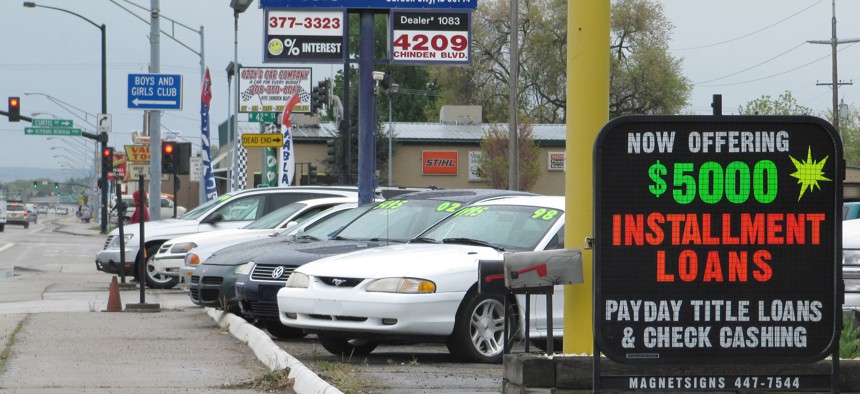Financial Institutions Working in Distressed Areas Call for More Federal Funding

CDFIs sometimes offer small dollar loans as an alternative to low-income residents needing to take out payday loans. AP Photo
“I have a strong suspicion that the current administration will propose yet again to slash the funding for the coming fiscal year,” says a Democratic appropriator.
Financial services providers working in underserved communities around the U.S. made a case on Capitol Hill Tuesday for boosting federal funding that supports their work.
President Trump’s past two budget requests have proposed sharply reducing spending that goes toward “community development financial institutions,” or CDFIs. But Congress has rebuffed these proposals and allotted funding above previous year levels.
CDFIs can take on various forms, like banks, credit unions and loan and venture capital funds. The common theme among them though is that they operate in areas, both urban and rural, that tend to lack widespread access to capital and banking services.
“In our market economy, capital flows to where it can secure the highest rate of return for the lowest risk,” Annie Donovan, a senior fellow with the Center for Community Investment, said during testimony before a House Appropriations subcommittee.
“Communities that are deemed too risky, or not profitable enough, are often bypassed by traditional financial institutions,” she added. “CDFIs correct for this market imperfection.”
Donovan cited estimates indicating that communities with poverty rates of 20 percent or higher receive investment equal to less than half what’s seen in places with rates under 20 percent.
The federal government’s CDFI fund dates back to the 1990s. Within it there are four main programs, as well as administration costs. CDFI fund budget authority has increased from around $209 million in fiscal 2013 to $250 million in fiscal 2019.
In fiscal 2018 and 2019 budget plans, the Trump administration requested just $14 million for CDFI spending for oversight of past awards and other administrative costs.
“If Congress did not step in to restore funding in both 2018 and 2019, CDFI grant programs would cease to exist in the future,” said U.S. Rep. Mike Quigley, the Illinois Democrat who chairs the Financial Services and General Government panel that conducted Tuesday’s hearing.
“I have a strong suspicion that the current administration will propose yet again to slash the funding for the coming fiscal year and once again it will be up to Congress to weigh the funding options for this bipartisan program,” he added.
Grace Fricks, is president and CEO of Access to Capital for Entrepreneurs, Inc., a Georgia-based nonprofit that focuses on helping businesses in underserved areas grow their companies by providing capital investments and other services.
She called on lawmakers to increase funding for the CDFI fund to $300 million.
Donovan urged them to appropriate an even larger sum, pointing to estimates that suggest there is a $156 billion investment gap annually in low-income communities, compared to higher income areas, and that CDFIs filled in only about 7 percent, or $11 billion of it, in 2018.
“When I hear my colleagues arguing for $300 million,” she said, “I would like us to go much higher than that. Because, again, you have to look at the scale of the problem.”
The biggest chunk of CDFI funding, roughly $150 million to $160 million in recent years, goes to a core program that provides both financial and technical assistance awards to eligible CDFIs, according to a Congressional Research Service report from last year.
CRS in its report explains that, as of fiscal 2017, the fund made awards of up to $2 million to certified CDFIs under the financial assistance component of this program.
Institutions that receive this funding can use it for lending, investing and other financing. The money can go toward businesses, as well as housing, or consumer loans, among other possibilities.
Donovan and others who testified on Tuesday emphasized that federal money flowing through the CDFI fund is “leveraged” and fosters additional investment—by some counts at a ratio of $12 of other investment for every $1 of federal money with some programs.
Among the other federal CDFI programs is one focused on financing for organizations working to bolster the supply and demand for nutritious foods in low-income neighborhoods—through efforts like developing grocery stores and strengthening distribution networks.
Another initiative, the Bank Enterprise Award program, provides formula-based grants to qualified banks that offer services in economically distressed places. A fourth program specifically focuses on Native American communities.
Bob Jones is president and CEO of United Bank, a $631 million bank headquartered in Alabama certified as a CDFI in 2010. Jones’ written testimony notes that, like all CDFIs, at least 60 percent of the bank’s lending and activities target low- and moderate-income areas. Nationwide he says there are 134 banks certified as CDFIs.
Several years ago, United used a CDFI fund Bank Enterprise award to create a small dollar lending program that serves customers with weak credit histories who might otherwise turn to payday lenders. Jones offered an example to lawmakers of a woman who the bank helped to consolidate four payday loans, one with an interest rate of 425 percent.
“BEA is critical for offsetting the cost of running a small-dollar loan program,” Jones said.
The $250 million allotted for federal CDFI programs in fiscal 2019 is equal to about 0.0056 percent of the total $4.4 trillion in expected federal outlays for the budget cycle.
Bill Lucia is a Senior Reporter at Route Fifty and is based in Olympia, Washington.

NEXT STORY: Coalition of Governors Push to Restore State, Local Tax Deduction






